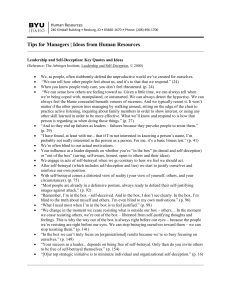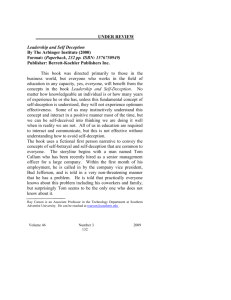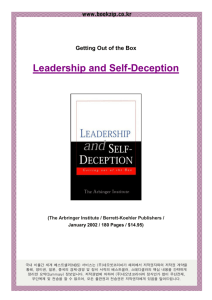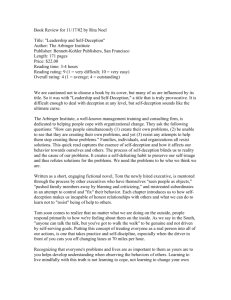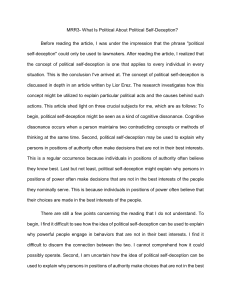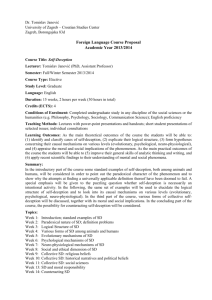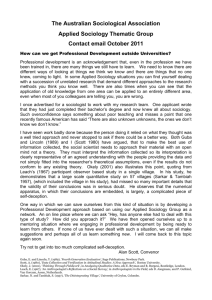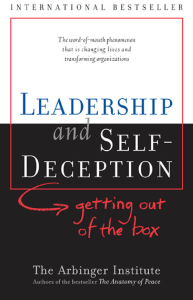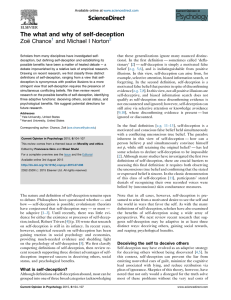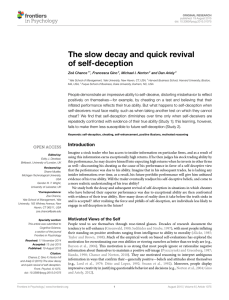In the Box
advertisement
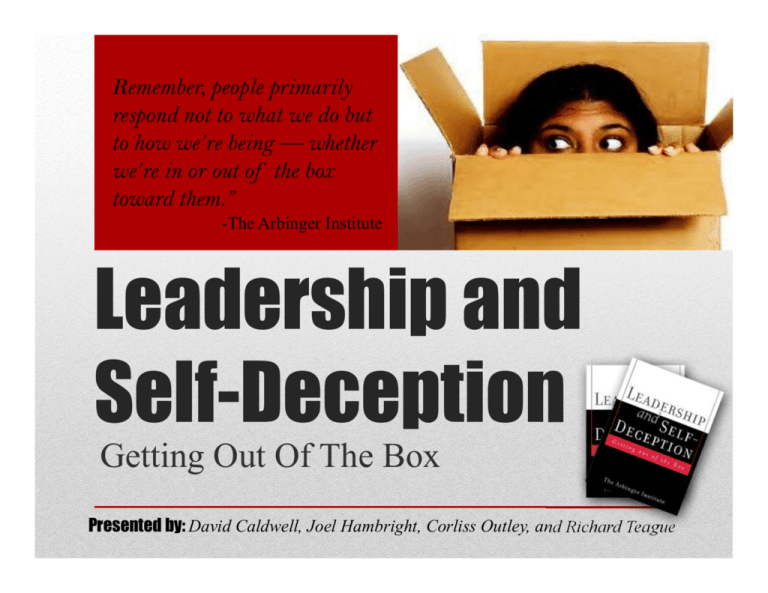
Remember, people primarily respond not to what we do but to how we’re being — whether we’re in or out of the box toward them.” -The Arbinger Institute Leadership and Self-Deception Getting Out Of The Box Presented by: David Caldwell, Joel Hambright, Corliss Outley, and Richard Teague WHAT IS THE BOX? Introduction and Overview of Self-Deception • Most professionals are diligent and hardworking but cause problems with their colleagues without knowing it. • This Self-deception is a blindness that is called being in-the-box in this book. • The way people relate to those around them causes problems that they are unaware of. • The example of Dr. Ignatz Semmelweis at Vienna general hospital in 1846. • The work situation is similar in the sense that people carry around a “germ”, their behavior, which spreads the problem around the office. • If one person does something in-the-box the automatic reaction from others is to respond by being in-the-box. In the Box In the Box Experiencing yourself as the person among objects Out of the Box Out of the Box Experiencing yourself as a person among people • A work situation could be a senior manager has information that she knows would be useful to another manager in the firm. She has the thought to share it with him . . . but she doesn't. • This would likely cause offence and may lead to retaliation. • The resentment in the other person encourages retreat into a box which mirrors the original negative behavior. • In-the-box behavior is seeing others as mere objects to achieve a selfcentered goal. • Out-of-the-box behavior involves seeing other people and one’s self as people and dealing with everyone's needs rather than just one’s own needs. • In any interaction ask yourself if you are regarding the other person as having similar hopes and needs as yourself, or whether they are just an object to you – as a threat, nuisance or problem. • People are much more smart, skilled and hardworking when they see, and are seen, straightforwardly – as people. • Involve your people in all aspects of a project and encourage their inputs, it brings out the best in them. • By doing it in a manner that benefits everyone. HOW DO WE GET IN THE BOX Entering “the box” • PREMISE: • Success in an organization and our influence as leaders depends upon whether we are in the box or not. • What leads one to to be “in the box”? SELF-BETRAYAL • An act contrary to what one feels he or she should do for another person is self-betrayal. • Self-betrayal leads to self-deception which leads us into “the box” • Being “in the box” affects everything we do! • Communication, Productivity, Critical Thinking, Stress, Relationships, Collaboration, Trust, Motivation Story of the Crying Baby • Bud’s son awakes crying in the middle of the night. His first impulse is to go to son so wife can sleep • Impulse was ignored—an act of “Self-Betrayal” • Why? • When his wife Nancy did not attend to his son, Bud viewed his wife as lazy, inconsiderate, unappreciative, insensitive, bad mom, bad wife. • This forced Bud to view himself as a victim, hardworking, important, fair, sensitive, good dad, good husband. Bud became “self-deceived”. • Consequence? • Bud entered “the box” by selfishly ignoring his instinct to do something to help someone else. Characteristics of Self-Betrayal 1. An act contrary to what I feel I should do for another 2. When I betray myself, I begin to see the world in a way that justifies my self-betrayal 3. When I see the world in a self-justifying way, my view of reality becomes distorted 4. So—when I betray myself, I enter the box 5. Over time, certain boxes become characteristic of me and I carry them with me 6. By being in the box, I provoke others to be in the box 7. In the box, we invite mutual mistreatment and obtain mutual justification. We collude in giving each other reason to stay in the box (collusion) Collusion • Someone in the box is self-deceived • Views of others in the workplace or in life are distorted • Actions are “self-justifying” in nature • Self-justification leads to blame • Story in book: Kate’s relationship with her son Bryan • Blame invites others to be “in the box”—a simple response to criticism from someone already in the box • In the box people need problems—it fulfills their self-justification and distorted view of others • Destructive cycle destroys productivity How does the box interfere with workplace productivity? • This is affected by what motivates us when we are “in the box” • This is defined as our focus: What Focus or Who Focus • Each focus is altered significantly for someone who is “in the box” What Focus • “In the box”—all effort is directed self-justification • “Out of the box”—outcomes, deliverables, success of the organization Who Focus • “In the box”—inward or “self” focus • “Out of the box”—outward focus on co-workers and overall success of the organization “You can’t focus on results because in the box you’re focused on yourself.” pg. 105 HOW DO WE GET OUT OF THE BOX “When you’re in the box, people follow you, if at all, only through force or threat of force. But that’s not leadership. That’s coercion. The leaders that people choose to follow are the leaders who are out of the box.” - Leadership & Self-Deception. Pg. 160 HOW DO WE GET OUT AND STAY OUT? Quit resisting what the humanity of others calls me to do for them. Cannot focus on ourselves. We change in the moment we cease resisting what is outside our box – others. Question your own virtue. Seeing and appreciating others as people. Acting on the sense or feeling of what we can do to help another. Knowing The Material “Merely knowing the material doesn’t get you out of the box. Living it does. And we’re not living it if we’re using it to diagnose others. Rather, we’re living it when we’re using it to learn how we can be more helpful to others – even to others like Chuck Staehli.” - Leadership & Self-Deception, Page 174 1) Self-betrayal leads to self-deception and “the box.” 2) When you’re in the box, you can’t focus on results. 3) Your influence and success will depend on being out of the box. 4) You get out of the box as you cease resisting other people. Living the material • Don’t try to be perfect. Do try to be better. • Don’t use the vocabulary – “the box,” and so on – with people who don’t already know it. Do use the principles in your own life. • Don’t look for others’ boxes. Do look for your own. • Don’t accuse others of being in the box. Do try to stay out of the box yourself. • Don’t give up on yourself when you discover you’ve been in the box. Do keep trying. • Don’t deny that you’ve been in the box when you have been. Do apologize; then just keep marching forward, trying to be more helpful to others in the future. • Don’t focus on what others are doing wrong. Do focus on what you can do right to help. • Don’t worry whether others are helping you. Do worry whether you are helping others. CONCLUSIONS Leadership in and out of the Box Summary An act contrary to what I feel I should do for another is called an act of “self-betrayal” In the box, we invite mutual mistreatment and obtain mutual justification we give each other reason to stay By being in the box, I provoke others to be in the box. Over time, certain boxes become characteristic of me, and I carry them with me. When I betray myself, I begin to see the world in a way that justifies my self-betrayal When I see the world in a selfjustifying way, my view of reality becomes distorted. So—when I betray myself, I enter the box. How does this relate to organizations • “People problems” that affect organizations are symptoms. • Difficulties relating to leadership, communication, motivation, conflict resolution, team-building, fear, trust, offense-giving, offense-taking, and so on, are often manifestations of a single, deeper problem: • self-deception, or “the box. • Our influence for good or bad is primarily a function of whether we are in or out of the box. Any behavior or skill we perform while in the box carries the attitude of the box, which is what others respond to. • Successful problem solving in organizations requires the same mentality: • only by considering how we are responsible for problems—by our being in the box—are we able to solve them. Discussion Questions • Why is self-deception a problem? • What do you think of the idea that we each contribute to the problems we complain about? • Who can tell me one thing they will do differently tomorrow based on what we talked about today? 21 Critic • The book does not provide many answers. • It highlights what the author believes doesn't work in leadership development/organizations: • Trying to change others • That you can “cope” with others • Leaving • Communicating • Implement new skills • Changing your behavior • The ONLY correct way is to remove self-betrayal! • Why? • Our leadership is undermined at every turn due to selfbetrayal. Conclusion 1. Within the box, the organization and its people are self-deceived. 2. Organizational self-deceptions and justifications cost valuable resources and rob the team and its people of opportunities. 3. Moving outside of the box leads to increased clarity. 4. Staying outside of the box, people and their accompanying resources are sustained and increase in value. 5. Out of the box processes, projects, programs, systems, and organizational culture can be developed and grow to support desired results. 6. Out of the box Leaders can see people (and the organization that is composed of these people) with clarity and potential—their influence can be positively felt and their future unfettered.
